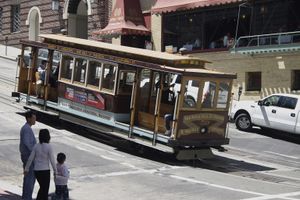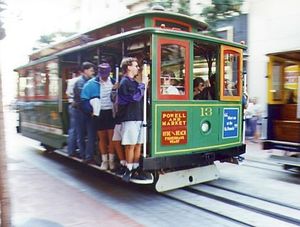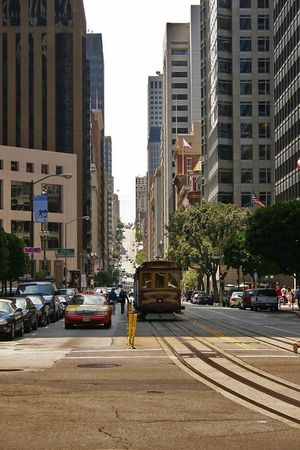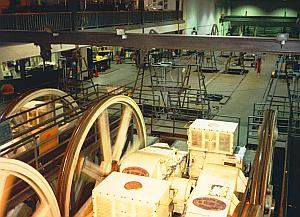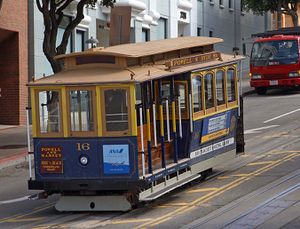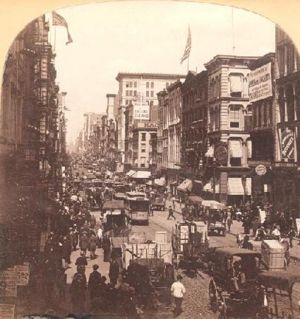Cable car (railway)
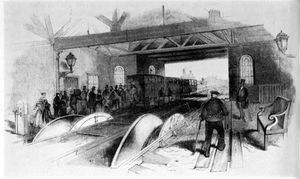
A cable car or cable railway is a mass transit system using rail cars that are propelled by a continuously moving cable running at a constant speed. Individual cars stop and start by releasing and gripping this cable as required. Cable cars are distinct from funiculars, where the cars are permanently attached to the cable.
Contents
Operation
The cable is itself powered by a stationary motor or engine situated in a cable house or power house. The speed at which it moves is relatively constant, although affected by the current load.
The cable car begins moving when a clamping device, called a grip, is connected to the moving cable. Conversely the car is stopped by detaching it from the cable and applying the brakes. This gripping and ungripping action may be manual, as was the case in all early cable car systems, or automatic, as is the case in some recent cable operated people mover type systems. Gripping must be an even and gradual process in order to avoid bringing the car to cable speed too quickly and unacceptably jarring the passengers.
In the case of manual systems, the grip resembles a very large pair of pliers, and considerable strength and skill are required to operate the car. As many early cable car operators discovered the hard way, if the grip is not applied properly, it can damage the cable, or even worse, become entangled in the cable. In the latter case, the cable car may not be able to stop and can wreak havoc along its route until the cable house realizes what is going on and halts the cable.
One claimed advantage of the cable car is its relative energy efficiency, because of the economy of centrally-located power stations, and the ability for cars going down hill to transfer energy to cars going up. However this advantage is not unique to cable cars, as electric cars fitted with regenerative braking offer the same advantages, and in any case they must be offset against the cost of moving the cable.
Because of the constant and relatively low speed, cable cars can be underestimated in an accident. Even with a cable car traveling at only 9 miles per hour, the mass of the cable car and the combined strength of the cables can do quite a lot of harm to pedestrians if hit.
History
The first cable-operated railway was the London and Blackwall Railway, which opened in east London, England, in 1840. However the rope available at the time proved too susceptible to wear and the system was abandoned in favour of steam locomotives after eight years. Though there may have been earlier attempts to pull cars by endless ropes, the first cable car installation in operation was the West Side and Yonkers Patent Railway in New York, which ran from 1 July 1868 to 1870. The cable technology used in this elevated railway involved collar-equipped cables and claw-equipped cars, and proved cumbersome. The line was closed and rebuilt, and reopened with steam locomotives.
The first cable cars to use grips were those of the Clay Street Hill Railroad, which later became part of the San Francisco cable car system. This building of this line was promoted by Andrew Smith Hallidie with design work by William Eppelsheimer, and it was first tested in 1873. The success of these grips ensured that this line became the model for other cable car transit systems, and this model is often known as the Hallidie Cable Car.
In 1881 the Dunedin cable tramway system opened in Dunedin, New Zealand and became the first such system outside San Francisco. For Dunedin, George Smith Duncan further developed the Hallidie model, introducing the pull curve and the slot brake; the former was a way to pull cars through a curve, since Dunedin's curves were too steep to allow coasting, while the latter forced a wedge down into the cable slot to stop the car. Both of these innovations were generally adopted by other cities, including San Francisco.
Cable cars rapidly spread to other cities, although the major attraction for most was the ability to displace horse-drawn (or other animal-drawn) systems rather than the ability to climb hills. Many people at the time viewed horse-drawn transit as unnecessarily cruel, and the fact that a typical horse could work only four or five hours per day necessitated the maintenance of large stables of draft animals that had to be fed (typically 30 lb (14 kg) of feed each day), housed, groomed, medicated and rested. Thus for a period economics worked in favour of cable cars even in relatively flat cities.
For example, the Chicago City Railway, also designed by Eppelsheimer, opened in Chicago, Illinois in 1882 and went on to become the largest and most profitable cable car system. As with many cities, the problem in flat Chicago was not one of grades but of transportation capacity. This caused a different approach to the combination of grip car and trailer. Rather than using a grip car and single trailer, as many cities did, or combining the grip and trailer into a single car, like San Francisco's California Cars, Chicago used grip cars to pull trains of up to three trailers.
In 1883 the New York and Brooklyn Bridge Railway was opened, which had a most curious feature: though it was a cable car system, it used steam locomotives to get the cars into and out of the terminals. After 1896 the system changed to one where a motor car was added to each train to manoeuvre at the terminals, while en route the trains were still propelled by the cable.
On 25 September 1883 a test of a cable car system was held by Liverpool United in Kirkdale. This was the first cable car system in Europe, but Liverpool United decided against implementing it. Other cable car systems were implemented in Europe, though, among which was the Glasgow District Subway, the first underground cable car system, in 1896. (London's first deep-level tube railway, the City & South London Railway, had earlier also been built for cable haulage but had been converted to electric traction before opening in 1890.) A few more cable car systems were built in the United Kingdom, Portugal and France, but European cities, having many more curves in their streets, were less suitable for cable cars than American cities.
Though some new cable car systems were still being built, by 1890 the cheaper to construct and simpler to operate electrically-powered trolley or tram started to become the norm, and eventually started to replace existing cable car systems. For a while hybrid cable/electric systems operated, for example in Chicago where electric cars had to be pulled by grip cars through the loop area, due to the lack of trolley wires there. Eventually, San Francisco became the only street-running manually-operated system to survive - Dunedin, the second city with such cars, was also the second-last city to operate them, closing down in 1957.
In the last decades of the 20th century cable traction in general has seen a limited revival as automatic people movers, used in resort areas, airports and huge hospital centers. Whilst many of these systems involve cars permanently attached to the cable, the system developed by Poma-Otis, a company formed by the merger of the cable car interests of the Pomagalski ski lift company and the Otis Elevator Company, allows the car to be decoupled from the cable under computer control, and can thus be considered a modern interpretation of the cable car.
Relation to Funiculars
A cable car is superficially very similar to a funicular but differs from such a system in that its cars are not permanently attached to the cable and can stop independently, whereas a funicular has cars that are permanently attached to the propulsion cable, which is itself stopped and started. A cable car cannot climb as steep a grade as a funicular, but many more cars can be operated with a single cable, making it more flexible, and allowing a higher capacity. During the rush hour on San Francisco's Market Street Railway, a car would leave the terminal every 15 seconds.
A few funicular railways operate in street traffic, and because of this operation are often incorrectly described a cable cars. Examples of such operation, and the consequent confusion, are:
- The Great Orme Tramway in Llandudno, Wales.
- Several street funiculars in Lisbon, Portugal.
Even more confusingly, a hybrid cable car/funicular line once existed in the form of the original Wellington Cable Car, in the New Zealand city of Wellington. This line had both a continuous loop haulage cable that the cars gripped using a cable car gripper, and a balance cable permanently attached to both cars over an undriven pulley at the top of the line. The descending car gripped the haulage cable and was pulled downhill, in turn pulling the ascending car (which remained ungripped) uphill by the balance cable. This line was rebuilt in 1979 and is now a standard funicular, although it retains its old cable car name.
Cities currently operating cable cars
The best known existing cable car system is the San Francisco cable car system in the Californian city of San Francisco. This is the oldest and biggest cable car system in permanent operation, and it is the only system to still operate in the traditional manner with manually operated cars running in street traffic.
Some other cities have a modern form of cable car, but they are often referred as people movers. These include:
- Laon, France (Poma 2000)
- Las Vegas, United States (three lines linking hotels)
Cities previously operating cable cars
Australia
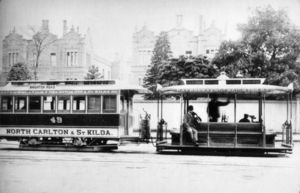
Colombia
France
New Zealand
- Dunedin (1881–1957, the Dunedin cable tramway system)
- Wellington (1902–1979, the original Wellington Cable Car hybrid system)
Portugal
United Kingdom
- Edinburgh (1899–1923))
- Glasgow (1896–1935)
- Liverpool (trial in 1883)
- London (1884–1909, connecting Archway with Highgate, the first cable car in regular operation in Europe)
- Matlock (1893–1927, the Matlock Cable Tramway)
Isle of Man
United States
- Baltimore, Maryland
- Binghamton, New York (trial in 1885)
- Brooklyn, New York
- Butte, Montana (1889–1897)
- Chicago, Illinois (1882–1906, the Chicago City Railway)
- Cincinnati, Ohio
- Cleveland, Ohio
- Denver, Colorado (1886–1900, the Denver Tramway)
- Grand Rapids, Michigan
- Hoboken, New Jersey (1886–1892)
- Kansas City, Missouri
- Los Angeles, California (1885–1902, the Second Street Cable Railway and others)
- New York, New York
- Newark, New Jersey (1888–1889)
- Oakland, California (1886–1899)
- Omaha, Nebraska
- Philadelphia, Pennsylvania
- Pittsburgh, Pennsylvania
- Portland, Oregon (1890–1904)
- Providence, Rhode Island
- Saint Louis, Missouri
- Saint Paul, Minnesota
- San Diego, California (1890–1892)
- Seattle, Washington (1888–1940)
- Sioux City, Iowa
- Spokane, Washington
- Tacoma, Washington (1891–1938)
- Washington, D.C. (1890–1899, part of the Washington streetcar system)
See also
Sources
- Of Cables and Grips: The Cable Cars of San Francisco, by Robert Callwell and Walter Rice, published by Friends of the Cable Car Museum, first edition, 2000.
External links
| Wikimedia Commons has media related to: Cable car on rails |
| Wikimedia Commons has media related to: Cable_transport |
Information
- Cable Car Museum
- Cable Car Guy
- The Cable Building (New York City) Broadway Cable car line.
Patents
- U.S. Patent 19736 -- Railroad track
- U.S. Patent 110971 -- Endless wire ropeway
de:Kabelbahn fr:Tramway à traction par câble ja:ケーブルカー nl:Kabeltram pl:Tramwaj linowy ru:Железная дорога или трамвай на канатной тяге sv:Kabelspårvagn
